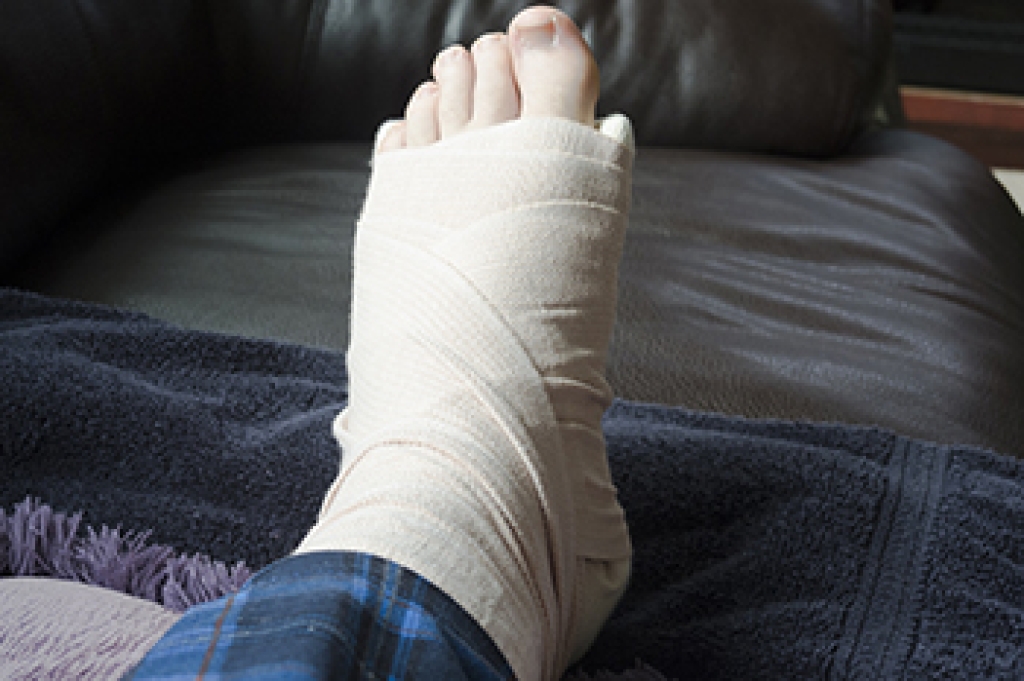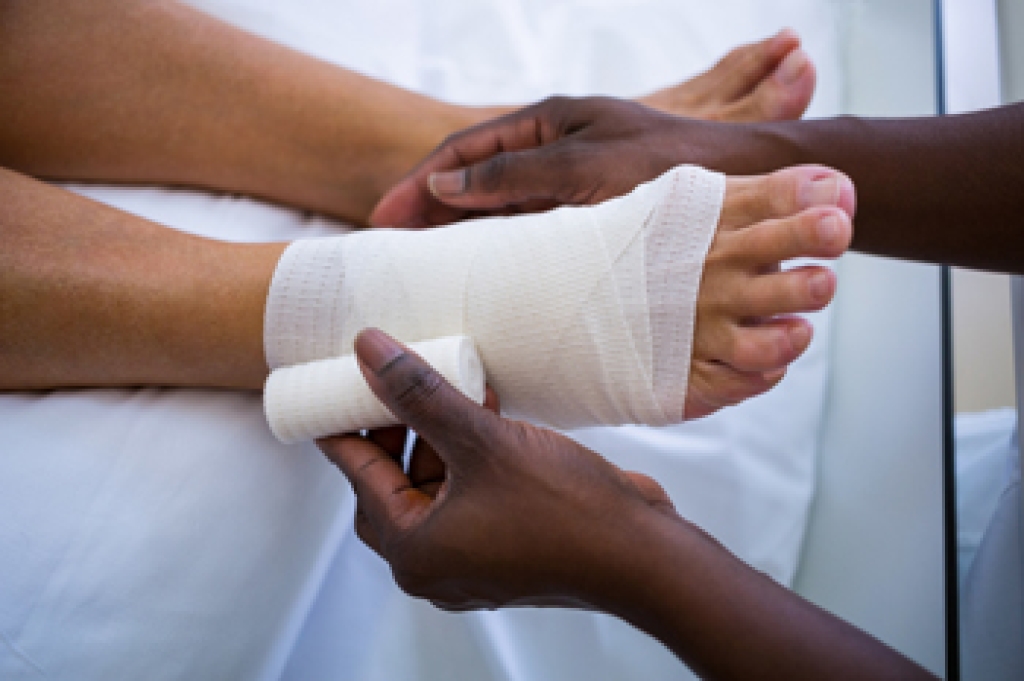Connect With Us
Blog
Blog
Identifying and Treating Foot Fractures

Foot fractures are broken bones resulting from trauma, falls, sports injuries, or repetitive stress. The feet may look swollen, bruised, or deformed, and in some cases the toes or midfoot may appear misaligned. Symptoms include sharp, intense pain at the time of injury, followed by tenderness, difficulty walking, or an inability to bear weight. Stress fractures, which are small hairline cracks in the bones, are common in athletes and dancers due to repetitive impact and may not be immediately visible on X-rays. A podiatrist can provide a thorough evaluation, including physical examination and imaging such as X-rays or an MRI, to confirm the diagnosis and determine the severity of the foot fracture. Treatment options include immobilization with casts or splints, protective footwear, activity modification, or in severe cases surgery. Early professional care promotes proper healing, reduces pain, and prevents long-term complications. If you suspect a foot fracture, it is suggested that you make an appointment with a podiatrist.
A broken foot requires immediate medical attention and treatment. If you need your feet checked, contact Katie Besselman, DPM from Advanced Podiatry. Our doctor can provide the care you need to keep you pain-free and on your feet.
Broken Foot Causes, Symptoms, and Treatment
A broken foot is caused by one of the bones in the foot typically breaking when bended, crushed, or stretched beyond its natural capabilities. Usually the location of the fracture indicates how the break occurred, whether it was through an object, fall, or any other type of injury.
Common Symptoms of Broken Feet:
- Bruising
- Pain
- Redness
- Swelling
- Blue in color
- Numbness
- Cold
- Misshapen
- Cuts
- Deformities
Those that suspect they have a broken foot shoot seek urgent medical attention where a medical professional could diagnose the severity.
Treatment for broken bones varies depending on the cause, severity and location. Some will require the use of splints, casts or crutches while others could even involve surgery to repair the broken bones. Personal care includes the use of ice and keeping the foot stabilized and elevated.
If you have any questions, please feel free to contact our office located in Saint Peters, MO . We offer the newest diagnostic and treatment technologies for all your foot care needs.
Facts About Diabetic Wound Healing

Diabetes can slow the body’s ability to heal wounds, particularly on the feet where circulation is reduced and nerve damage is often present. High blood sugar levels interfere with blood flow and damage small vessels, making it harder for oxygen and nutrients to reach injured tissue. When this happens, even a small blister or cut on the foot can turn into a deep ulcer. Nerve damage, known as neuropathy, can reduce sensation, so a person may not feel pain or notice an injury developing. Diabetic foot ulcers are prone to infection because bacteria thrive in the warm, moist environment of shoes and because immune responses are weakened. A podiatrist can evaluate circulation, remove dead tissue to promote healing, and monitor for infection or other complications. If needed, a podiatrist may recommend specialized footwear, orthotic devices, or surgery to prevent limb loss. If you have foot ulcers related to diabetes, it is suggested that you make an appointment with a podiatrist for management of this serious condition.
Wound care is an important part in dealing with diabetes. If you have diabetes and a foot wound or would like more information about wound care for diabetics, consult with Katie Besselman, DPM from Advanced Podiatry. Our doctor will assess your condition and provide you with quality foot and ankle treatment.
What Is Wound Care?
Wound care is the practice of taking proper care of a wound. This can range from the smallest to the largest of wounds. While everyone can benefit from proper wound care, it is much more important for diabetics. Diabetics often suffer from poor blood circulation which causes wounds to heal much slower than they would in a non-diabetic.
What Is the Importance of Wound Care?
While it may not seem apparent with small ulcers on the foot, for diabetics, any size ulcer can become infected. Diabetics often also suffer from neuropathy, or nerve loss. This means they might not even feel when they have an ulcer on their foot. If the wound becomes severely infected, amputation may be necessary. Therefore, it is of the upmost importance to properly care for any and all foot wounds.
How to Care for Wounds
The best way to care for foot wounds is to prevent them. For diabetics, this means daily inspections of the feet for any signs of abnormalities or ulcers. It is also recommended to see a podiatrist several times a year for a foot inspection. If you do have an ulcer, run the wound under water to clear dirt from the wound; then apply antibiotic ointment to the wound and cover with a bandage. Bandages should be changed daily and keeping pressure off the wound is smart. It is advised to see a podiatrist, who can keep an eye on it.
If you have any questions please contact our office located in Saint Peters, MO . We offer the newest diagnostic and treatment technologies for all your foot and ankle needs.
Rheumatoid Arthritis and Its Impact on the Ankles

Rheumatoid arthritis is an autoimmune condition in which the immune system mistakenly attacks the lining of the joints. It often affects the smaller toe joints first, leading to tenderness, swelling, and stiffness that can gradually spread to the ankles. As inflammation progresses, the joints may weaken and become painful during daily activities. Causes include an overactive immune response and risk factors include family history, age, and smoking. When rheumatoid arthritis involves the feet and ankles, walking and balance can become difficult. A podiatrist can help by providing custom orthotics, footwear guidance, and supportive treatments that ease pressure and improve joint function. If your ankles are stiff or swollen, it is suggested that you consult a podiatrist who can offer you relief solutions, helping you to manage this condition.
Because RA affects more than just your joints, including the joints in your feet and ankles, it is important to seek early diagnosis from your podiatrist if you feel like the pain in your feet might be caused by RA. For more information, contact Katie Besselman, DPM of Advanced Podiatry. Our doctor will assist you with all of your podiatric concerns.
What Is Rheumatoid Arthritis?
Rheumatoid Arthritis (RA) is an autoimmune disorder in which the body’s own immune system attacks the membranes surrounding the joints. Inflammation of the lining and eventually the destruction of the joint’s cartilage and bone occur, causing severe pain and immobility.
Rheumatoid Arthritis of the Feet
Although RA usually attacks multiple bones and joints throughout the entire body, almost 90 percent of cases result in pain in the foot or ankle area.
Symptoms
- Swelling and pain in the feet
- Stiffness in the feet
- Pain on the ball or sole of feet
- Joint shift and deformation
Diagnosis
Quick diagnosis of RA in the feet is important so that the podiatrist can treat the area effectively. Your doctor will ask you about your medical history, occupation, and lifestyle to determine the origin of the condition. Rheumatoid Factor tests help to determine if someone is affected by the disease.
If you have any questions, please feel free to contact our office located in Saint Peters, MO . We offer the newest diagnostic and treatment technologies for all your foot care needs.
Recovery Process of an Ankle Avulsion Fracture

An ankle avulsion fracture occurs when a small piece of bone is pulled away from the main bone by an injured ligament, tendon, or muscle. This injury often happens during a sudden twist, fall, or misstep, and it can involve surrounding soft tissues, such as ligaments, tendons, muscles, and nerves. Symptoms include swelling, bruising, pain, and difficulty walking. Most patients recover in about four to six weeks with proper care and protection. A podiatrist can confirm the diagnosis with imaging, guide your treatment, support healing of the soft tissues, and help restore strength and stability to the ankle. If you have ankle pain after an injury or have trouble putting weight on your foot, it is suggested that you consult a podiatrist who can accurately diagnose and treat the injury.
Broken ankles need immediate treatment. If you are seeking treatment, contact Katie Besselman, DPM from Advanced Podiatry. Our doctor can provide the care you need to keep you pain-free and on your feet.
Broken Ankles
A broken ankle is experienced when a person fractures their tibia or fibula in the lower leg and ankle area. Both of these bones are attached at the bottom of the leg and combine to form what we know to be our ankle.
When a physician is referring to a break of the ankle, he or she is usually referring to a break in the area where the tibia and fibula are joined to create our ankle joint. Ankles are more prone to fractures because the ankle is an area that suffers a lot of pressure and stress. There are some obvious signs when a person experiences a fractured ankle, and the following symptoms may be present.
Symptoms of a Fractured Ankle
- Excessive pain when the area is touched or when any pressure is placed on the ankle
- Swelling around the area
- Bruising of the area
- Area appears to be deformed
If you suspect an ankle fracture, it is recommended to seek treatment as soon as possible. The sooner you have your podiatrist diagnose the fracture, the quicker you’ll be on the way towards recovery.
If you have any questions, please feel free to contact our office located in Saint Peters, MO . We offer the newest diagnostic and treatment technologies for all your foot care needs.
Blog Archives
- 2025
- 2024
- 2023




